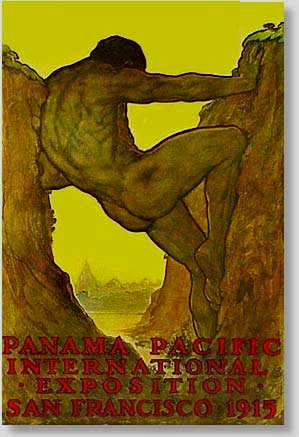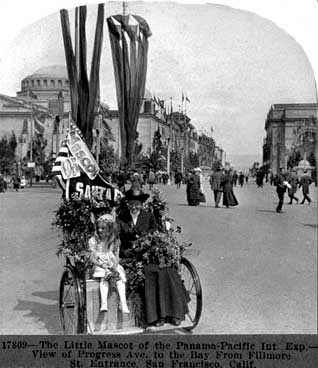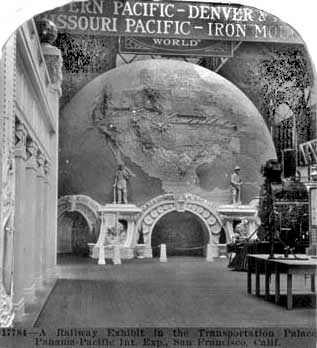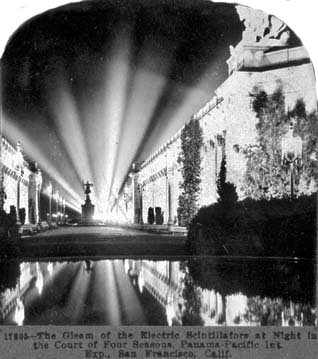See 16 Hand-Colored Views of PPIE in PowerPoint (900kb)
Panama-Pacific International
Exposition
San Francisco, 1915
Description of the Exposition
Site

The Exposition site combines to an extraordinary degree the qualities of beauty, adaptability and
convenience. It is a natural amphitheatre, fronting on the wonderful
island-dotted Bay of San Francisco, just
inside the famous Golden Gate. Towering, wooded heights flank it at each end, while at its back the hills
roll up sharply. All this is in the very heart of the best residential district of San Francisco and within
fifteen minutes’ street car ride from the City Hall.
The view facing north is across the sparkling
waters of the Bay— a
land-locked harbor which resembled a great mountain lake more than an arm of the sea. It is rimmed
around by mountain, with haughty Tamalpais towering over all. Under the turquoise California sky,
drenched with sunshine and color, it is a scene at once exquisitely beautiful and solemnly
majestic.
With this wonderful scene as a background, the
architects, artists and landscape gardeners of the Exposition have planned and erected a city straight out of a
beautiful dream. It can not be described in words nor adequately shown in picture, although an attempt to
give the reader of its general color effect appears elsewhere in this booklet.The proximity of the site to a world gateway is a
wonderful advantage. Through the portals of the Golden Gate the nations of the earth can bring their richest
offerings to the very gates of the Exposition, avoiding a long continental haul and consequent damage from
reshipping.
The site adapts itself to the carrying out of
wonderful aquatic displays. Carnivals, maneuvers by the fleets of all nations, international yacht racing,
motor boat racing, exhibitions by submarines and hydroplanes, all will be indulged in in the immediate
foreground of the Exposition palaces. The entire navies of the world can here assemble and land their crews
right on the edge of the beautiful “Marina.”
 The main exhibit palaces, eleven in number,
contain, under a comprehensive and representative classification, examples of the resources and
achievements along all lines of human endeavor, which are divided into departments as
follows: The main exhibit palaces, eleven in number,
contain, under a comprehensive and representative classification, examples of the resources and
achievements along all lines of human endeavor, which are divided into departments as
follows:
“A”—Fine Arts; “B”—Education;
“C”—Social Economy; “D”—Liberal Arts;
“E”—Manufactures and Varied Industries;
“F”—Machinery; “G”—Transportation;
“H”—Agriculture; “I”—Agriculture (food products);
“K”—Horticulture; “L”—Mines and
Metallurgy.
These eleven great palaces, together with
Festival Hall, form the central setting of a beautiful picture, flanked on the city side by “The
Zone” or amusement section and other end by the buildings of the various states and the pavilions of
the foreign nations. These latter join the aviation field, race track, and live stock exhibit, terminating in the
grounds of a great military reservation, the Presidio, where the competitive drills and army maneuvers will
take place.
In formation the eight main exhibit
palaces—Education, Liberal Arts, Manufactures, Varied Industries, Agriculture, Food Products, Transportation and
Mines and Metallurgy—represent a quadrangle, being bisected by an avenue east and west and intersected by
avenues north and south, the intersections marking the three great courts. The facades of the palaces are the
walls of these courts and partake of the particular style of architecture dominating the court on which they
front. These eight palaces are flanked on the east by the great Palace of Machinery and on the west by the
Palace of Fine Arts.
Passing through the main gate on the city side
the visitor enters the great South Garden, 3000 feet in length, on the right extremity of which can be seen
the beautiful Festival Hall. To the extreme left is the Palace of Horticulture. Immediately in front is the
Main Tower or “Tower of Jewels.” This great garden, itself a marvel of landscape engineering
skill, is but one side of a magic carpet on which these beautiful palaces are set, the 300-foot wide
“Marina” and its grand esplanade, with its floricultural splendors, forming the other side, the
pattern threading its winding way through the various courts and recesses over the entire grounds, forming a
correlated whole which, for wondrous beauty, has never been equaled.
 Passing from this great garden under the arch of
the main tower the visitor enters the “Court of the Universe,” the largest of five courts of the
Exposition. This is the meeting place of the Eastern and Western hemispheres, and the decorative scheme
on each side is typical of this theme. On the extreme right and left are two great Triumphal Arches, the one
on the right, which leads to the Court of Abundance, being surmounted by a magnificent statuary group,
“The Nations of the East,” the figures symbolizing life in the Orient, while the arch on the
left, leading to the Court of the Four Seasons, has a group of the same proportions, “The Nations of
the West,” symbolical of life in the Occident. Straight ahead is the colossal Column of Progress,
surmounted by the “Adventurous Bowman” shooting the arrow toward the
West.
Passing from this great garden under the arch of
the main tower the visitor enters the “Court of the Universe,” the largest of five courts of the
Exposition. This is the meeting place of the Eastern and Western hemispheres, and the decorative scheme
on each side is typical of this theme. On the extreme right and left are two great Triumphal Arches, the one
on the right, which leads to the Court of Abundance, being surmounted by a magnificent statuary group,
“The Nations of the East,” the figures symbolizing life in the Orient, while the arch on the
left, leading to the Court of the Four Seasons, has a group of the same proportions, “The Nations of
the West,” symbolical of life in the Occident. Straight ahead is the colossal Column of Progress,
surmounted by the “Adventurous Bowman” shooting the arrow toward the
West.
To the right, under the “Arch of the
Rising Sun,” is the avenue leading to the “Court of Abundance,” which terminates at
its southern extremity into the “Court of Flowers,” one of the minor courts; while to the left,
under the “Arch of the Setting Sun,” is the avenue leading to the beautiful “Court of
the Four Seasons.” Continuing straight ahead one comes to the edge of the spacious Yacht Harbor
and the center of the Grand Esplanade or “Marina.” Long after the Exposition is
over—when it is only a fond and loving memory—this esplanade will remain to
grace and enhance the natural beauties of San Francisco Bay.
This is the first Exposition to have a uniform
color scheme. From one end to the other, throughout the entire area of the site—whether it be
within the boundaries of “The Zone” or among the buildings and pavilions of the states and
foreign nations, or in the midst of the great palaces themselves— the same beautiful, soft,
entrancing color scheme prevails. Under the direction of Jules Guerin, the famous colorist, the world will be
shown a study in natural tints unlike anything ever before attempted and which at once commands the
attention and admiration of all beholders. The palaces themselves are of a soft, cold, gray tin, a kind of
smoked ivory, at once pleasing and restful to the eyes, and which forms a foundation or background for the
vivid coloring of doorways, the
vari-tinted shrubbery, the beds of flowers and matchless lawns.
 One of the most attractive and beautiful features
of this Exposition is the electrical illumination. By an entirely new system of flood lighting, a soft, restful,
yet perfect light pervades the courts at night, revealing in wonderful clearness the facades and walls of the
palaces and the natural colors of the shrubbery and flowers, giving an effect as bright and soft as daylight.
One of the most attractive and beautiful features
of this Exposition is the electrical illumination. By an entirely new system of flood lighting, a soft, restful,
yet perfect light pervades the courts at night, revealing in wonderful clearness the facades and walls of the
palaces and the natural colors of the shrubbery and flowers, giving an effect as bright and soft as daylight.
A Trip to the
Exposition
A trip to the Panama-Pacific International
Exposition not only affords educational advantages equal to a university course, but is the vacation
opportunity of a lifetime.
From an educational standpoint, do you realize
which this Exposition means to you? This is the first time in the history of man the entire world is known
and in intercommunication. Even the discovery of the north and south poles has been accomplished, and the
wide expanses of land and water have been correctly mapped out. In speaking of the earth, the qualification
“The known world” is no longer necessary. For the first time all the world is
known.
The
Panama-Pacific International Exposition is an encyclopedia of modern achievement. You are afforded an
opportunity to make a comparative study of the methods and manners of modern civilization; the conditions
and means of living—the hygiene, the religions—in short, the objects and accomplishments of all the peoples
of all the world. Such an event will not occur again while you live.
Besides this, think of the pleasure you will
derive from two or three weeks to a month vacation visiting California. You need an outing, free from care
and responsibility. Here is a chance to combine travel, pleasure, rest and instruction. To cross the great
American desert, now a land of cultivated farms; to climb the Rockies and the Great Sierra Mountains and
feast your eyes upon their rugged grandeur; to visit California and the Pacific slope and delight in their
sun-clad beauty and blooming fertility; to look upon the vast stretches of the mighty ocean that sweeps
to the shores of the fabled East; and then to visit the Jewel City of the world’s greatest
Exposition—magnificent, beautiful, alluring—this is your opportunity if you will
but take it.
Think of some of the glories that await you at
the end of the golden trail:
An expenditure of fifty million dollars in construction.
Fifty millions more in the intrinsic value of exhibitions.
Six hundred and twenty-five acres of Palaces and gardens entrancingly beautiful.
Eleven great Exhibit Palaces crowded with objects of interest from every portion of the globe.
Spacious courts and miles on miles of ornamented avenues.
More than two hundred and fifty groups of statuary by world’s masters.
Huge mural paintings, masterpieces by the greatest artists.
A Million Dollar Auditorium in San Francisco’s new Civic Center.
An art palace, the architecture of which is more beautiful than any part of ancient Greece, and which
contains the largest and most comprehensive collection of pictures ever collected and shown in one
place.
Near two score Pavilions of the States and Foreign Nations vying with each other in architecture, displays
and hospitality.
Sixty-five acres of amusement concessions, several of which cost $250,000 to build.
An Aviation Field for the contest of the air and athletic sports.
A Drill Ground, where ten thousand troops may drill at one time.
A Livestock Exhibit embracing the entire world’s best birds and animals.
An electrical illumination at night absolutely unique and unequaled.
And you may visit hospital San Francisco and mingle in her interesting, cosmopolitan and
pleasure-loving atmosphere at less effort and less expense than ever before. The railroads are making every
preparation for the special accommodation and comfort of their patrons. Very low rates are quoted from all
points to California, giving the opportunity of going one way and returning by any other. Make your
reservations now—you will never regret it.
SOURCE: Panama-Pacific International Exposition Brochure, 1915
See: “San Francisco—Fairs-Expositions” for more about the 1915 Panama-Pacific International Exposition.
|